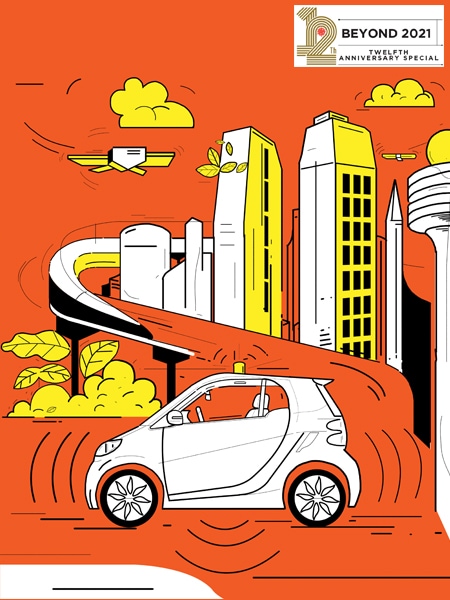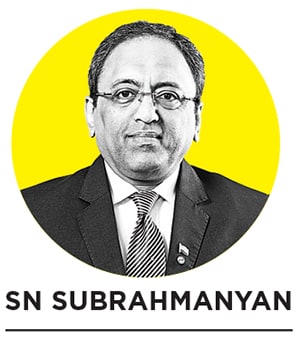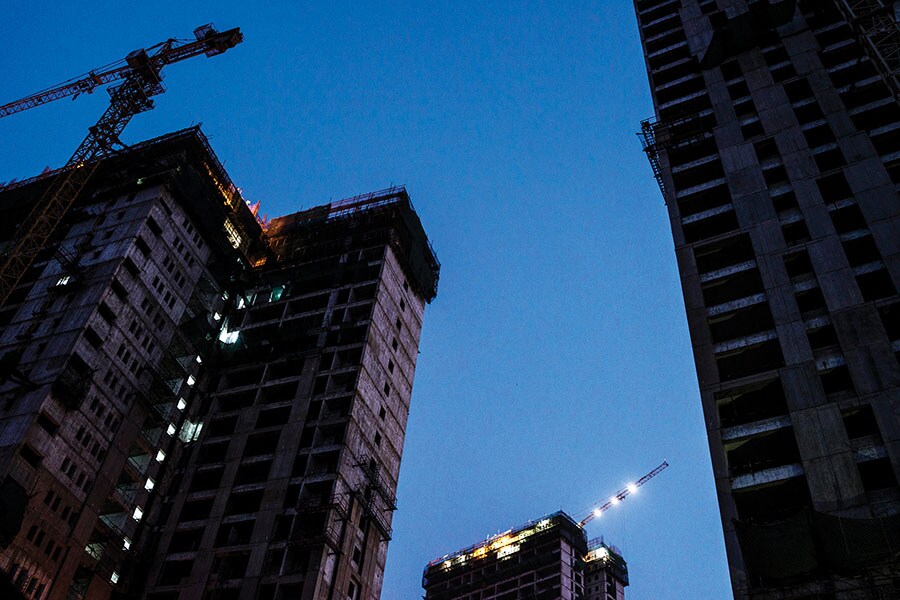Sci-fi to reality—Infrastructure to ride on smart solutions; cannot ignore envir
Digital revolution and new technologies will redefine the industry, with the energy sector being the biggest harbinger of change, the CEO & MD of Larsen & Toubro writes



Illustration: Sameer Pawar
 The future of infrastructure will truly be like bringing sci-fi into reality. Smart cities, smart highways with neural networks, intelligent buildings with real-time digitally-monitored utilities, artificial intelligence (AI)-induced traffic management systems, driverless cars, clean energy, green fuel and greener emissions.
The future of infrastructure will truly be like bringing sci-fi into reality. Smart cities, smart highways with neural networks, intelligent buildings with real-time digitally-monitored utilities, artificial intelligence (AI)-induced traffic management systems, driverless cars, clean energy, green fuel and greener emissions.
Consider safety at workplace enabled through a simulated (virtual reality) system that can ‘mimic’ potential dangers, hazards and feel of the ecosystem. The ‘connected workman’ will don ‘smart wearables’ that can detect altitude, temperature and other environmental conditions, and monitor vitals such as heartbeats, pulse rates, blood pressure and fatigue. Use of AI models, sensors and beacons will generate timely alerts in real time to prevent incidents.
Consider, Internet of Things (IoT) technology connecting a number of machines deployed across hundreds of project sites, communicating with each other in real time. Consider remote monitoring and providing insights into various performance parameters of equipment. Consider using neural-control technology to move and control machinery at sites.
Consider drones flying overhead, scanning sites constantly, inspecting the works and using the data collected to predict and solve problems before they arise.
If these sound too far-fetched, in reality, all of the above are work-in-progress. Last year, in December, we successfully 3D-printed a ground-plus-one-floor building with reinforcement for the first time in India at Kanchipuram, Tamil Nadu. 3D concrete printing is a technology disruptor with the potential to radically redefine construction methods and fast-track conversion of innovative design ideas to product. Today, we are well-positioned to push the boundaries of automated robotic construction. With India aggressively pursuing creating 60 million houses under the Housing for All programme by 2022, 3D printing technology of concrete houses will certainly give a huge fillip to the mass housing segment under the Prime Minister Awas Yojana (PMAY) scheme.
Project sites are now equipped with multiple sensors and intelligent gateways on equipment, enabling the streaming of real-time operational, production and condition data on location, movement, switch on/switch off and idling time, number of hours worked, volume of work done, pressure, temperature and fuel consumption. Armed with this goldmine of information, planners can evolve strategies to improve production, reduce costs and enhance productivity.
For the construction and infrastructure industry, the volume of data being continuously generated by a wide range of sources will require new software and algorithms, skilled data analysts, better information management and insight.
Smart buildings employ communication and automation technologies to integrate various building subsystems, which otherwise typically operate in silos. These sub-systems, including HVAC, lighting, fire protection, access control systems, surveillance, smart meters, water, UPS, elevators, etc share information to optimise the performance of buildings. A smart building is in sync with smart grids which enable it to optimise its energy requirements.
 With high economic growth and fast-growing populations leading to significant urbanisation, the demand for new infrastructure is predicted to see massive growth in the coming decades
With high economic growth and fast-growing populations leading to significant urbanisation, the demand for new infrastructure is predicted to see massive growth in the coming decades
Image: Sanjit Das / Bloomberg via Getty Images
With an experience spanning over 500 buildings, including high-rises, hospitals, commercials complexes, IT parks and factories, we are now investing to create a unique Building and Energy Management System (iBEMS) which integrates several technologies to provide measurable benefits to customers. iBEMS provides event-based data retrieval for real-time data access (data analytics, reports, 3D visualisation) along with historic data support with a user-friendly interface.
Indeed, data gathering and storage must become more intelligent in the future to ensure that information is used to drive improvements in the way systems operate and infrastructure is built and used. The digital technologies used to operate and maintain infrastructure will continue to evolve once infrastructure is built. Infrastructure owners and operators will, therefore, need to develop strategies to integrate and use different generations of technology as well as intelligent information, effectively managed and reused.
Companies which have relied on one traditional approach will be challenged and therefore should become agile and innovative. Collaborative approach and industry partnerships will become vital.
In future, IoT will power smart buildings built with new energy-generating or breathable materials. Smart cities will adapt instantly to changing circumstances. Construction will be faster, with the advent of 3D printing. Also, 4D printing will have self-transforming objects responding to changes in heat, sound or moisture levels to change shape. Wearable technology will reduce worker injury and improve their health while increasing productivity.
Infrastructure will shift from concrete and steel to include new materials which respond to their surroundings. Thinking only about design and construction will become an outdated concept as infrastructure becomes multi-functional.
New, disruptive ideas will emerge for making mass transit faster, safer and less damaging to the environment. Direct neural control over devices and vehicles will be accessible to the industry.
A whole host of other new innovations, both in terms of regulations and skills, await us. Multi-pronged security solutions on turnkey basis—that are modern and reliable for a whole spectrum of smart infrastructure—will be the norm. Smart buildings, smart energy, smart water solutions, smart transportation and logistics, emergency response systems, real-time information systems and smart cities are close by and will become standard features sooner than later.
Moving further, the biggest harbinger of change in the future of infrastructure will be brought about by the energy sector. Hydrogen economy, carbon capture, biofuels, electric vehicles, green buildings, water desalination etc will be some of the major disruptors of the future. The world is gradually advancing towards adopting hydrogen as the prime mover for energy storage, away from the prevalent fossil fuel. Electrolyser technology, used for splitting water using renewable power for production of what is called ‘green hydrogen’, is on the cusp of large-scale commercial usage.
Green hydrogen was named among the World Economic Forum’s top 10 “most exciting technologies" to have emerged in 2020, and Bloomberg predicts hydrogen could meet up to 24 percent of the world’s energy needs by 2050, creating a market worth $600 billion.
In India, five pilot plants are being set up to ascertain the commercial viability of ‘green hydrogen’. With a target of 175 GW by 2022 and 450 GW by 2030 of renewable power, India can potentially be a large producer of hydrogen. Surplus energy storage, the biggest challenge in renewables, can easily be solved by hydrogen to store energy using power-to-gas or power-to-liquid technologies.
Hydrogen could also be an ultimate replacement for oil and natural gas. In a few cases, it could be an intermediate between fossil fuels and renewables-based electricity. However, for hydrogen to make a significant contribution to clean energy transitions, it needs to be adopted in sectors where it is almost completely absent, such as transport, buildings and power generation.
The government’s National Hydrogen Mission is expected to lay down the various approaches and India’s medium- to-long-term strategy to exploit an opportunity in being a sizeable player in the new energy industry. L&T is seriously exploring to provide integrated capability in the hydrogen business.
Hydrogen is also set to revolutionise the transport system in the future. Apart from the electricity and industrial sector, there’s adoption of fuel cell electric vehicles (FCEV) in the mobility sector, where onboard hydrogen will power the vehicle for much larger distances than the present vehicles are capable of. FCEV is currently limited by handling and availability of hydrogen.
Infrastructure is overdue for change. The digital revolution will further redefine the sector. For companies to capitalise on it, digital transformation must encompass the whole organisation, and pushed down the supply chain to benefit. To be sure, the infrastructure industry will become increasingly focussed on innovation and both contractors and customers will become less risk averse. The shape and offers of the infrastructure industry will change significantly, with new business models, products and services.
undefinedConsidering the inevitability of a “green future", our focus should increasingly be directed toward environmental impact[/bq]
Considering the inevitability and significance of a “green future", our focus should increasingly be directed toward environmental impact.
L&T is one of the few companies which started to report sustainable practices long before the regulator mandated the use of business responsibility and sustainability reporting formats for various industries. We at L&T fully recognise our responsibility as a global engineering, construction, and manufacturing conglomerate to make our operations sustainable and are fully committed to build a safe and prosperous future. We focus not only on our operations, but also engineer sustainable solutions for our customers. We approach these solutions holistically, going beyond just the environmental regulations that govern them, to fully consider the communities and environments they impact. We aim to create long-term value by operating sustainably in the ecological, social and economic spaces.
Development and destruction need not be synonymous—and L&T is proving it every day. Our focus has broadly been on people, the communities we operate in, the environment at large, and on expanding our green portfolio. Thrust areas such as employee safety and well-being, community development through health, education, water and sanitation, skill-building, energy conservation, GHG emission reduction have been identified and the progress on them has been good.
Building a green portfolio that cuts across several existing capabilities and adjacencies, green and clean technologies must become a part of our mainstay offerings to cater to sectors such as renewable energy generation from solar and wind, energy storage and transmission, decarbonisation, hydrogen generation and utilisation.
Infrastructure is a political and economic priority in India, as it is across the world. Increasingly, complex projects are being commissioned to stimulate economies, upgrade old systems and cater to growing and changing populations. With high economic growth and fast-growing populations leading to significant urbanisation, the demand for new infrastructure is predicted to see massive growth in the coming decades.
Our holistic adoption and embrace of technology will significantly push smart infrastructure needs to sustain the future of our nation.
â— The writer is chief executive officer & managing director of Larsen & Toubro
First Published: May 21, 2021, 14:50
Subscribe Now